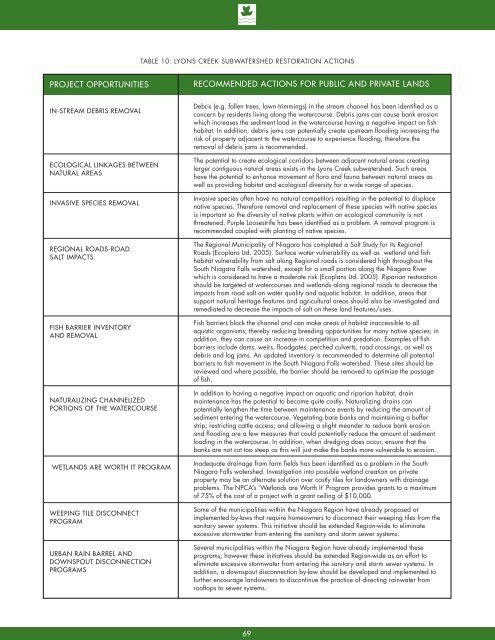8132 - NPCA SNF Watershed Report.indd - Niagara Peninsula ...
8132 - NPCA SNF Watershed Report.indd - Niagara Peninsula ...
8132 - NPCA SNF Watershed Report.indd - Niagara Peninsula ...
You also want an ePaper? Increase the reach of your titles
YUMPU automatically turns print PDFs into web optimized ePapers that Google loves.
Table 10: Lyons Creek Subwatershed Restoration ActionsPROJECT OPPORTUNITIESRECOMMENDED ACTIONS FOR PUBLIC AND PRIVATE LANDSIN-STREAM DEBRIS REMOVALECOLOGICAL LINKAGES BETWEENNATURAL AREASINVASIVE SPECIES REMOVALREGIONAL ROADS-ROADSALT IMPACTSFISH BARRIER INVENTORYAND REMOVALNATURALIZING CHANNELIZEDPORTIONS OF THE WATERCOURSEWETLANDS ARE WORTH IT PROGRAMWEEPING TILE DISCONNECTPROGRAMURBAN RAIN BARREL ANDDOWNSPOUT DISCONNECTIONPROGRAMSDebris (e.g. fallen trees, lawn trimmings) in the stream channel has been identified as aconcern by residents living along the watercourse. Debris jams can cause bank erosionwhich increases the sediment load in the watercourse having a negative impact on fishhabitat. In addition, debris jams can potentially create upstream flooding increasing therisk of property adjacent to the watercourse to experience flooding; therefore theremoval of debris jams is recommended.The potential to create ecological corridors between adjacent natural areas creatinglarger contiguous natural areas exists in the Lyons Creek subwatershed. Such areashave the potential to enhance movement of flora and fauna between natural areas aswell as providing habitat and ecological diversity for a wide range of species.Invasive species often have no natural competitors resulting in the potential to displacenative species. Therefore removal and replacement of these species with native speciesis important so the diversity of native plants within an ecological community is notthreatened. Purple Loosestrife has been identified as a problem. A removal program isrecommended coupled with planting of native species.The Regional Municipality of <strong>Niagara</strong> has completed a Salt Study for its RegionalRoads (Ecoplans Ltd. 2005). Surface water vulnerability as well as wetland and fishhabitat vulnerability from salt along Regional roads is considered high throughout theSouth <strong>Niagara</strong> Falls watershed, except for a small portion along the <strong>Niagara</strong> Riverwhich is considered to have a moderate risk (Ecoplans Ltd. 2005). Riparian restorationshould be targeted at watercourses and wetlands along regional roads to decrease theimpacts from road salt on water quality and aquatic habitat. In addition, areas thatsupport natural heritage features and agricultural areas should also be investigated andremediated to decrease the impacts of salt on these land features/uses.Fish barriers block the channel and can make areas of habitat inaccessible to allaquatic organisms, thereby reducing breeding opportunities for many native species; inaddition, they can cause an increase in competition and predation. Examples of fishbarriers include dams, weirs, floodgates, perched culverts, road crossings, as well asdebris and log jams. An updated inventory is recommended to determine all potentialbarriers to fish movement in the South <strong>Niagara</strong> Falls watershed. These sites should bereviewed and where possible, the barrier should be removed to optimize the passageof fish.In addition to having a negative impact on aquatic and riparian habitat, drainmaintenance has the potential to become quite costly. Naturalizing drains canpotentially lengthen the time between maintenance events by reducing the amount ofsediment entering the watercourse. Vegetating bare banks and maintaining a bufferstrip; restricting cattle access; and allowing a slight meander to reduce bank erosionand flooding are a few measures that could potentially reduce the amount of sedimentloading in the watercourse. In addition, when dredging does occur, ensure that thebanks are not cut too steep as this will just make the banks more vulnerable to erosion.Inadequate drainage from farm fields has been identified as a problem in the South<strong>Niagara</strong> Falls watershed. Investigation into possible wetland creation on privateproperty may be an alternate solution over costly tiles for landowners with drainageproblems. The <strong>NPCA</strong>’s ‘Wetlands are Worth It’ Program provides grants to a maximumof 75% of the cost of a project with a grant ceiling of $10,000.Some of the municipalities within the <strong>Niagara</strong> Region have already proposed orimplemented by-laws that require homeowners to disconnect their weeping tiles from thesanitary sewer systems. This initiative should be extended Region-wide to eliminateexcessive stormwater from entering the sanitary and storm sewer systems.Several municipalities within the <strong>Niagara</strong> Region have already implemented theseprograms; however these initiatives should be extended Region-wide as an effort toeliminate excessive stormwater from entering the sanitary and storm sewer systems. Inaddition, a downspout disconnection by-law should be developed and implemented tofurther encourage landowners to discontinue the practice of directing rainwater fromrooftops to sewer systems.69
















